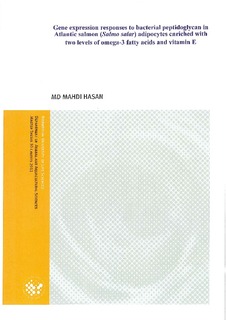| dc.description.abstract | Adipose tissue is recognized as an active endocrine organ, influencing metabolism, inflammation and immunity in mammals. The size of the visceral adipose tissue in farmed Atlantic salmon has increased due to the exposure to lipid-rich formulated diets and immune functions in adipose tissue in Atlantic salmon have been studied with different exposure like lipopolysaccharide (LPS), omega-3 and 9 fatty acids (FAs). However, this thesis has focused on gene expression responses of Atlantic salmon adipocytes to inflammatory inducer peptidoglycan (PGN), different doses of omega-3 polyunsaturated fatty acids and vitamin E. We used primary cell culture of the differentiating adipocytes that harbours the precursors of the white adipocytes to study the gene expression responses of Atlantic salmon adipocytes to different doses of polyunsaturated fatty acids, vitamin E and inflammatory inducer peptidoglycan at Nofima. Maturing adipocytes isolated from Atlantic salmon were incubated at 13°C until achieving the confluence stage. Cells were treated with with the different doses of omega-3 FAs (0.30 and 0.05 mM) and in addition with either vitamin E (0.1 mM), PGN (10 mM) or vitamin E+PGN 20 days. Quantitative real time PCR was the preferred approach in this project. We examined the expression level of adipogenic (C/EBPα), fatty acid and energy metabolism (FAS, HSD17B4, PGC-1α, UGT), intracellular antioxidant (GPx-2), immune; pro-inflammatory (TNF-α, STAT1, LECT2, IL-15, IL-1β, IL13a2, ALOX5 and ALOX5AP), anti-inflammatory (RTEL1, IL-1RA, IL-10 and TGF-β), related genes to understand the effects of different mentioned treatments. Adipogenesis was observed from low omega-3 FAs treatments and vitamin E which turned on synthesis of fat-specific, uptake and storage of long chain fatty acids. Immunostimulant was prone to lower the level of C/EBPα. Moreover, high doses of omega-3 FAs induced lipogenic enzyme (FAS) which influenced to increase with combined treatments of vitamin E and PGN. 17β-HSD4 was induced for inactivation of steroids and β-oxidation by vitamin E with high doses of omega-3 FAs. In addition, PGC-1α is a transcriptional coactivator for conditional energy metabolism was down-regulated with high doses of omega-3 FAs treatments. UGT which involves in glucuronidation, was induced more with low doses of omega-3 FAs treatments which play role in synergistic effect with low doses of vitamin E. Nonetheless, immunostimulant (PGN) with high doses of omega-3 FAs suppressed induction of FAS, 17β-HSD4, PGC-1α and UGT. There was no difference between expression level of vitamin E (intracellular anti-oxidant) induction from low and high doses of omega-3 FAs. But significant effect of vitamin E was observed from high+vitamin E treatments which could balance the synthesis of fatty acids. However, vitamin E and PGN showed the opposite effect on adipose cells. The average counter inductions of pro-and anti-inflammatory genes were observed with all treatments. Interestingly, the high expression levels of pro-inflammatory genes were observed in the high+PGN+vitamin E group which was affected by the equally up-regulated expression of anti-inflammatory genes. PGN and high doses of omega-3 showed the highest levels of inflammatory genes expression. However, low doses of omega-3 FAs influenced to suppress induction of pro-inflammatory genes and showed effects on expression of anti-inflammatory genes on average. In conclusion, low doses of omega-3 FAs with vitamin E have positive effects on adipogenesis. But, vitamin E for inhibition of oxidative damage was more prominent with combined treatments of high doses of omega-3 FAs and vitamin E which was affected by PGN under low omega-3 FAs treatments. All pro-inflammatory genes were down-regualted with low doses of omega-3 FAs treatments and vitamin E helped to induce them. However, high doese of omega-3 FAs induced higher level of anti-inflammatory adipokines which may prevent inflammation from fatty acids syntheis. Importantly, immunostimulant (PGN) was invloed to induce all pro-inflammatory genes except IL-13Rα2 with low+PGN treatments which was counteracted by IL-10, TGF-β and IL-6 simultaneous induction. The significance difference from control was set at p≤0.05 (t-test). | no_NO |
